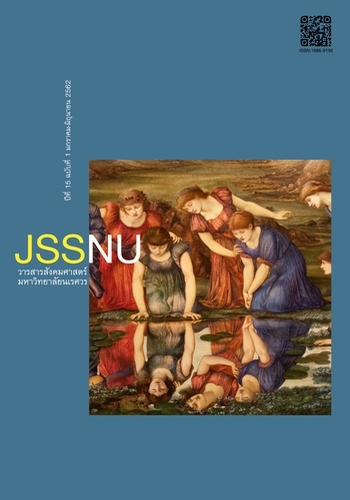On the Significance of Self in SociologySerin Punnahitanond
Main Article Content
Abstract
In writing this paper I attempt to revisit the concept of self in order to shedlight on the nature of one of the most important ideas concerning human characteristicsfound to be involved in social behavior and performance. The contents ofthis paper start with the definition of self to be followed by its first appearance, itsformation, the development of its aspects and functions, and the way in which contemporarysociologists have used the term “self” in various hyphenated forms, e.g.self-conception, self-perception, self-evaluation, self-esteem, etc. Sales describes theself-concept theory to account for the multi dimensionality of self-concept togetherwith an empirical study on a facet of self-concept. Finally I present one interestingempirical study of deviant behavior using self-identify for explaining juvenile delinquencyin the U.S.
Downloads
Article Details
References
Bem, D. 1972. “Self-Perception Theory.” In Advances in Experimental Social Psychology,
Volume B, ed. L. Berkowitz, 1-62. N.Y.: Academic Press.
_______. 1978. “Self-Perception Theory.” In Cognitive Theories in Social Psychology, ed. L.
Berkowitz, 221-282. San Francisco: Academic Press.
_______. 1978. “Persons, Situations, and Template Matching: Theme and Variation.” In
Constistency in Social Behavior: The Ontario Symposium, eds. M. Zanna, E.T. Higgins
& C.P. Herman, Vol.2, 173-186. Hillsdale, N.J.: Lawrence Erlbaum.
Bergson, H. 1935. The Two Sources of Morality and Religion. London: Macmillan.
Bloom, L., and P. Selznick. 1977. Sociology: A Text with Adapted Readings. 6th edition.
N.Y.: Harper and Row, Inc.
Blumer, H. 1969. Symbolic Interaction: Perspective and Method. Englewood, Cliff, N.J.:
Prentice-Hall, Inc.
Collins, R. 1975. Conflict Sociology. New York: Academic Press.
Cooley, C.H. {1902} 1964. Human Nature and the Social Order. N.Y.: Scribner.
Cohen, A.R. 1966. Deviance and Control. Englewood Cliffs, N.J.: Prentice-Hall, Inc.
Dewey, J. {1887} 1967. The Early Works, 1882-1898; Volume 2: 1887 Psychology. Carbondale:
Southern Illinois University Press.
Feldman, R.S. 1985. Social Psychology. N.Y.: McGraw Hill.
Freud. S. {1920} 1930. A General Introduction to Psychoanalysis. London: Boni and Riverli.
Gerard, H.B., and J.M. Rabbie. 1961. “Fear and Social Comparison.” Journal of Abnormal
Social Psychology, 62: 586-592.
Goffman, E. 1956. “Embarrassement and Social Organization.” American Journal of Sociology, 62: 264-274.
______. {1959} 1963. The Presentation of Self in Everyday Life. Garden City: Doufle Day.
______. 1961. Asylums: Essays on the Social Situation of Mental Patients and Other Inmates.
Harmondsworth: Penguin Books.
______. 1967. Interaction Behavior: Essays in Face-to-Face Behavior. New York: Anchor Books.
Grecas. 1982. “The Self-Concept.” Annual Review of Sociology, 8: 1-33.
Grecas. 1985. “Self-Concept.” Social Science Encyclopedia. London: Routledge and Kegan Paul.
Harvey, O.J., and C. Consalvi. 1953. “Status and Conformity to Pressmes in Informal Group.”
Journal of Abnormal and Social Psychology, 60: 182-187.
Hyman, H.H. 1942. “The Psychology of Status.” Arch Psychology, No.269.
James, W. 1890. The Principles of Psychology. 2 Volumes. New York: Henry Holt.
______. 1900. Psychology. New York: Holt, Rinehart & Winston.
Kotarba, J.A., and F. Audrea, eds. 1984. The Existential Self in Society. Chicago: The University
of Chicago Press.
Krech, D., et al. 1958. “Brain Chemistry and Adaptive Behavior.” In Biological and Biochemical
Bases of Behavior, eds. H.F. Harlow and C.N. Woolsey, 367-400. Madison,
Wisconsin: University of Wisconsin.
Krech, D., et al. 1962. Individual in Society: A Textbook of Social Psychology. New York:
McGraw Hill.
Levin, K. 1969. “Differentiation of the Personality.” Experimental Social Psychology. 2nd
edition, 233. N.Y.: Harper and Holt.
Levy, D.M. 1937. “Primary Affect Hunger.” American Journal of Psychiatry, 94: 643–652.
______. 1943. Maternal Overprotection. New York: Columbia University Press.
Loftland, J. 1969. Deviance and Identity. Englewood Cleffs: Prentice-Hall.
Mann, L. 1969. Social Psychology. Sydney: John Wiley and Sons.
McCall, G.L., and J.L. Simmons. 1966. Identities and Interaction. N.Y.: The Free Press.
McClelland, D.C., et al. 1972. “The Drinking Man: Alcohol and Human Motivation.” In The
Drinking Man: Alcohol and Human Motivation, eds. D.C. McClelland, W.N. Davis, R.
Kalin & E. Wanner, 376-315. New York: Free Press.
McDougall, W. 1908. Introduction to Social Psychology. London: Methuen.
______. 1926. Introduction to Social Psychology. Boston: J.W. Luce.
Mead, G.H. {1934} 1962. Mind, Self and Society. Chicago: University of Chicago Press.
______. 1982. The Individual and the Social Self. Chicago: University of Chicago Press.
Merton, R.K. 1940. “Bureaucratic Structure and Personality.” Social Forces, 18: 560-568.
Murphy, G. 1933. General Psychology. New York: Harper and Row.
______. 1947. Personality: A Biosocial Approach to Origins and Structure. New York: Harper
and Brothers.
Newcomb, T. {1950} 1954. Social Psychology. Scranton, PA: Dryden Press.
Reiss, A.J., Jr. 1951. “Delinguency as a Failure of Personal and Social Control.” ASR, 16:
196-207.
______. 1962. “The Social Integration of Peers and Queers.” Social Problems, 9: 102-120.
Rokeach, M. 1972. Beliefs, Attitudes and Values: A Theory of Organization and Change.
San Francisco, California: Josey-Bass, Inc.
Rosenberg, M. 1957. Occupations and Values. Glencoe, IL: Free Press.
______ 1979. Conceiving the Self. N.Y.: Basic Book
______. 1995. “Global Self-Esteem and Specific Self-Esteem.” ASR, 60(1): 142-144.
Schacter, S. 1959. The Psychology of Affiliation. California: Stanford University Press.
Schwartz, M., and S. Stryker. 1970. Deviance, Selves and Others. Washington, DC: American
Sociological Association.
Sherif, M., and C.N. Sherif. 1968. Social Psychology. N.Y.: Harper and Row.
Singlemann, P. 1972. “Exchange as Symbolic Interaction.” ASR, 38: 414-424.
Stone, G.P. 1962. “Appearance and the Self,” pp.86-118. In Human Behavior and Social
Processes, ed. A.M. Rose. Boston: Houghton Mifflin.
Stryker, S. 1968. “Identity Salience and Role Performance: The Relevance of Symbolic Interaction
Theory for Family Research.” Journal of Marriage and the Family, 30: 558-564.
Turner, R. 1968. “The Self-Conception in Social Interaction.” In The Self-in Interaction, eds.
C. Gordon and K.J. Gergen, 93-106. N.Y.: Wiley.
Whyte, W. 1956. The Organization Man. N.Y.: Simon and Schuster.
Wiley, N. 1988. “The Micro-Macro Problem in Social Theory.” Sociological Theory, 6: 254–261.
William, J. 1900. Psychology. N.Y.: Holl, Rinchart and Winston.
Zimbardo, P.G., and R. Fformica. 1963. “Emotional Comparison and Self-Esteem as Determinants
of Affiliation.” Journal of Personality, 31: 141–162.
Zimbardo, P.G., and N.E. Miller. 1966. “The Facilitation of Exploration by Hunger in Rats.”
Journal of Comparative and Physiological Psychology, 51: 43-46.


